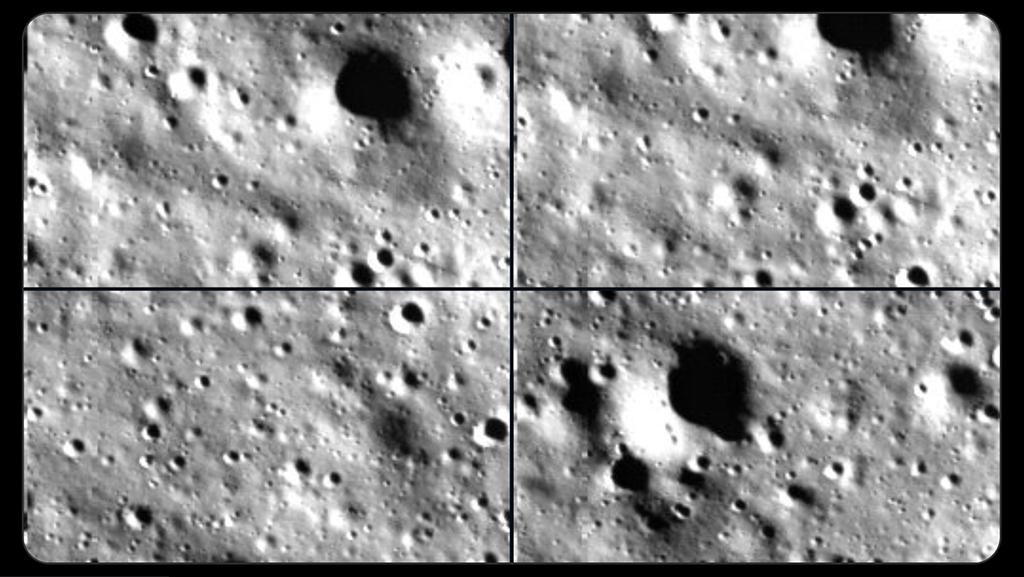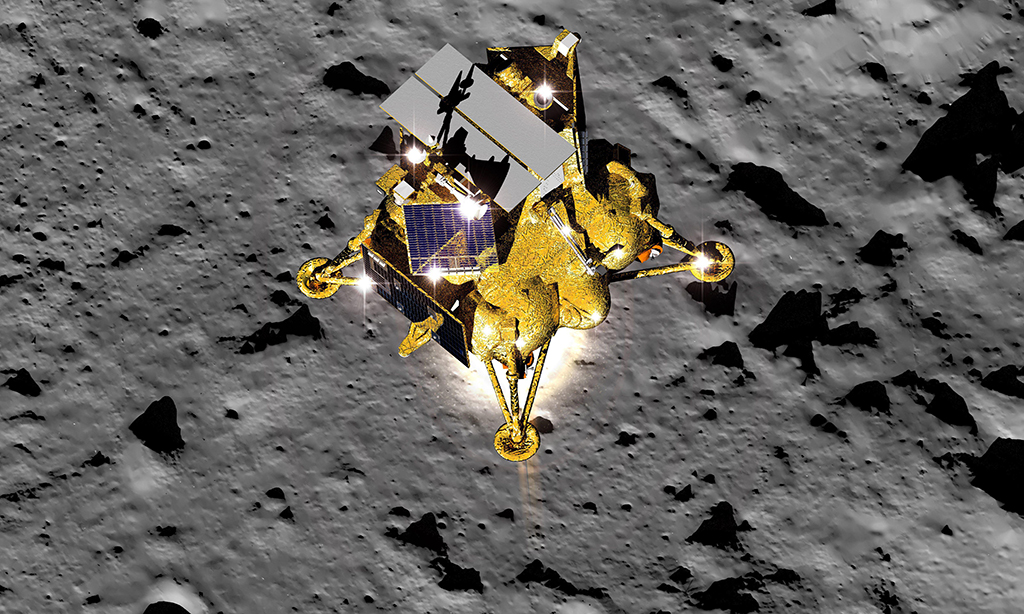
ISRO released these images of the lunar surface from Chandrayaan-3’s Lander Horizontal Velocity Camera taken during the spacecraft's descent.
With a successful landing on the Moon’s south pole, India trumped a Russian effort to conduct the first in situ science experiments in a water-bearing region of increasing interest for the exploration and development of deep space.
“This success belongs to all of humanity, and it will help Moon missions by other countries in the future,” Indian Prime Minister Narendra Modi said during a video call with flight controllers after the successful landing of the Chandrayaan-3 mission on Aug. 23.
- Japan to make next landing attempt
- Two commercially developed U.S. landers to follow
“I am confident that all countries in the world, including those from the global south, are capable of achieving such feats,” Modi said.
The touchdown at 8:33 a.m. EDT caps a four-year effort to recover from India’s initial attempt in 2019 to land a spacecraft on the Moon and sets the stage for the country’s more ambitious efforts to join the U.S., Russia and China in developing and flying crewed vehicles. Those countries also are the only nations that have successfully landed spacecraft on the Moon.
With the successful touchdown of Chandrayaan-3, India eclipsed Russia’s effort to reach the lunar south pole, which remote observations show is replete with water ice trapped in permanently shadowed craters.

Russia’s Luna-25 spacecraft was lost after a thruster burn on Aug. 19 that was intended to lead to a touchdown two days later. Russia’s Roscosmos State Space Corp. confirmed on Aug. 20 that Luna-25—the country’s first mission to the Moon in nearly 50 years—had crashed into the lunar surface.
The thruster burn lasted longer than planned, nudging the spacecraft lower than its intended flight path, which was to bring it no closer than 11 mi. above the surface. The accident will be investigated by a special interdepartmental commission, Roscosmos said.
The 4,000-lb. Luna-25 was expected to explore lunar soil in order to confirm the existence of water ice deposits in the polar areas and to study the Moon’s exosphere during a year-long mission.
Russia’s return to the Moon was to be followed by several more announced missions: Luna-26, -27 and -28 in 2027-30. Those initiatives are unlikely to be canceled, but they certainly will fall lower in the priority list of programs supported by government subsidies in the current harsh economic environment in Russia, Russian space expert Vitaly Yegorov notes.

Four days after the Luna-25 crash, India's 8,600-lb. Chandrayaan-3 settled onto the lunar surface near Manzinus crater, some 75 mi. away from the Russian probe’s intended landing site near Boguslavsky crater.
Chandrayaan-3’s 40-day journey to the Moon began with a launch on July 14. The spacecraft performed five Earth-bound maneuvers to raise its orbit, followed by a translunar injection burn on Aug. 1 to send it on a path toward the Moon.
Chandrayaan-3 reached the Moon four days later and put itself into orbit. The spacecraft then gradually lowered its altitude to position itself for the final phase of flight.
The lander module separated from the propulsion module on Aug. 17, setting the stage for a deboost maneuver on Aug. 20 ahead of the landing attempt.
The probe’s descent began at about 8:15 a.m. EDT from an elliptical orbit with a high point of 83 mi. and a low point of 15.5 mi. The spacecraft’s three braking engines fired up at an altitude of about 18 mi. to begin the descent. Chandrayaan-3 slowly lowered its altitude to 4.6 mi. as its velocity decreased from 3,758 mph to 800 mph in 690 sec., according to The Indian Space Research Organization’s (ISRO) livestream from the Telemetry Tracking and Command Network in Bengaluru.
After both rough and fine braking, the spacecraft entered its vertical descent phase at 2,625 ft. above the Moon’s surface and slowly reduced both its vertical and horizontal velocity until it touched down.
“The entire mission operation, right from launch until landing, happened flawlessly as per the timeline,” Chandrayaan-3 Project Director P. Veeramuthuvel said.
Chandrayaan-3 is designed to operate for one lunar day—the equivalent of two weeks. ISRO is spending 6.1 billion rupees ($74 million) on its third lunar mission. The project follows the partially successful Chandrayaan-2 mission in 2019, which ended when a lander and rover crashed into the Moon during the final descent phase. The Chandrayaan-2 orbiter remains operational, surpassing its expected one-year design life, and is being used to support the Chandrayaan-3 lander, named Vikram, as well as a companion 57-lb. rover named Pragyan and various payloads for in situ scientific experiments.
Vikram carries Chandra’s Surface Thermophysical Experiment, which will measure the thermal properties of the lunar surface near the polar region; the Radio Anatomy of Moon Bound Hypersensitive ionosphere and Atmosphere Langmuir Probe, which will measure the changes in the near-surface plasma ions and electron density over time; and the Instrument for Lunar Seismic Activity, which will measure seismic activity in the area surrounding the landing site and indicate the lunar crust and mantle structure.
In addition to the ISRO payloads, the lander also carries a NASA-provided Laser Retroreflector Array. This passive instrument can provide lunar ranging by reflecting laser light from other spacecraft, enabling it to measure the distance between the two.
On the Pragyan rover, there is an Alpha Particle X-Ray Spectrometer, which will infer the mineral and chemical composition of the lunar surface, as well as a Laser-Induced Breakdown Spectroscope, which can determine the elemental composition of the lunar soil and rocks near the landing site.
The propulsion module has an experimental payload of its own, the Spectropolarimetry of Habitable Planet Earth, which is intended to study the signatures of the polarization of light of Earth in the near-infrared range.
Three more missions to the Moon are scheduled before year-end. Up next is Japan’s Smart Lander for Investigating Moon, which will demonstrate technologies for pinpoint landing technology necessary for future lunar probes. Launch is targeted for Aug. 26.
In November and December, two commercially developed and operated landers owned by U.S.-based Intuitive Machines and Astrobotic will attempt landings for NASA and other customers. A launch onboard a SpaceX Falcon 9 is targeted for Nov. 15, and one by United Launch Alliance’s first Vulcan rocket is planned in the fourth quarter of the year.
Two previous private efforts to land spacecraft on the Moon—by Israel’s SpaceIL in 2019 and by Japan’s iSpace in April 2023—failed. Overall, since the U.S Ranger 3 mission in 1962, there have been 53 attempts to land spacecraft on the lunar surface. Only 23 of those attempts have been successful, according to data collected by Jonathan McDowell, a Harvard University astrophysicist who tracks satellite launches.
—With Apurva Mahajan in Washington




